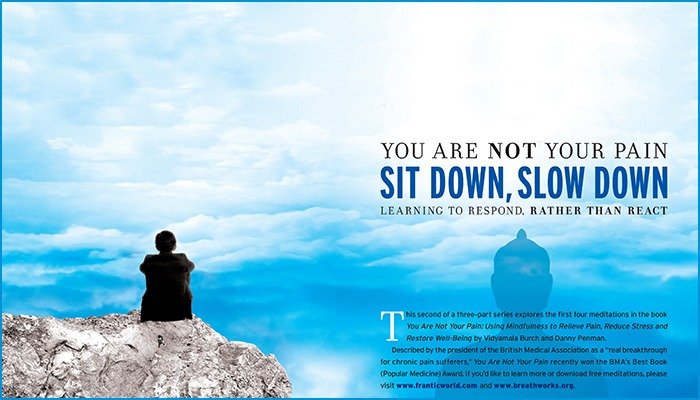You Are Not Your Pain – Sit Down, Slow Down

This second of a three-part series explores the first four meditations in the book You Are Not Your Pain: Using Mindfulness to Relieve Pain, Reduce Stress and Restore Well-Being by Vidyamala Burch and Danny Penman. Described by the president of the British Medical Association as a “real breakthrough for chronic pain sufferers,” You Are Not Your Pain recently won the BMA’s Best Book (Popular Medicine) Award. If you’d like to learn more or download free meditations, please visit www.franticworld.com and www.breathworks-mindfulness.org.uk.
If you’re feeling overwhelmed, frantic or rushed, you probably don’t have time to meditate. Ironically, that’s exactly when it’s important to make time to slow down. Meditation may sound too “out there,” but keeping an open mind may yield powerful, practical results worth exploring.
While meditation may seem like a waste of time, think of the time it will free up for the people and activities you love if you feel better, more often. Think of it as mental exercise, a fitness program for the mind. It is not self-indulgent; it’s giving yourself the time and tools to heal and regain control of your suffering; a practical way of dealing with pain, illness and stress.
Negative habits can create and trap pain, suffering and stress. Dissolving them enables the most effective healing and relief. You Are Not Your Pain includes an eight-week course that explores two different ways to develop mindfulness: the meditation itself (which takes ten minutes and can be tracked on the accompanying CD) and Habit Releasers, enjoyable activities that encourage curiosity and progressively help break down negative habits of thinking and behaving. [SEE SIDEBAR ON PAGE 41.]
It is ideal to approach the meditations and Habit Releasers realistically and with positive intentions. While it’s most effective to attempt meditations six days a week, life happens. Compassion, especially for yourself, is its own lesson. Try to avoid attacking yourself and start again to find your best path toward relief.
WEEK ONE introduces the Body Scan Meditation, inviting you to move your awareness around the body and focus thoughts on any sensation it finds. This simple meditation lays the foundation for the rest of the program and highlights the difference between thinking about a sensation and experiencing it directly. This is also an excellent stress reliever.
The anticipation of pain will cause the body to tense and increase suffering. So much energy can be placed in trying to avoid pain or being afraid of it. This meditation encourages watching your pain with calm acceptance to begin to transform suffering.
The Habit Releaser suggested for Week One focuses on nature. The natural world is a powerful stress reliever and mood booster. Spend a little time with nature each day this week to help put things into perspective. How does your body feel soaking in the sun? Can you hear scampering squirrels? How does your body feel sitting on a park bench?
VICIOUS EMOTIONAL CYCLES
Experiencing emotion is a multistep process. Fear, for example, involves a sense of threat, a racing heart rate, body tension and the brain’s decision to fight or flee. We feel the emotion, quickly label it and then must interpret it.
When it comes to chronic pain, the brain spots something that looks like pain, turns up its sensory amplifiers for a closer look and primes the body for action.This stress reaction then makes the body tense up, aggravating any aches, pains, injuries or illnesses. This, in turn, makes the body even more sensitive to pain. It triggers a vicious cycle. Secondary suffering goes wild.
To make matters worse, these responses can become hardwired into your brain so that every experience passes through a pain-tinted filter. In a sense, your brain has learned to automate your suffering. It has turned into habit. Your pain is real. Over time the brain’s pain matrix adapts in the way a muscle adapts to exercise—it grows bigger and stronger. It’s almost as if years of suffering have made “pain muscles” grow in size so that they are more efficient at suffering.
WEEK TWO introduces the Breathing Anchor, being aware of thoughts and emotions and letting goof the struggle with them. Most suffering is actually a habitual reaction to mental and physical triggers that cannot be overcome until they are recognized. Getting out of autopilot and monitoring your thoughts and behavior will allow you to edit it. Focusing on the breath during this meditation stimulates the parasympathetic or calming aspect of the nervous system.
WEEK THREE introduces the Mindful Movement meditation. Pain and illness have a significant impact on overall fitness, flexibility and the ability to carryout daily tasks. Broadly based on yoga and Pilates, You Are Not Your Pain offers specific and sometime small movements to help reverse inactivity and rebuild physical confidence.
If you don’t already, this is the week to consider keeping an “activity management” diary. The only way to manage your pain effectively is to understand it and know what activities aggravate it and which ones ease it. Tracking yourself physically and emotionally is key.
WEEK FOUR encourages Compassionate Acceptance, turning toward your difficulties, rather than trying to avoid them. Like almost every area of life, we tend to avoid or ignore thoughts, feelings, emotions and sensations that we find difficult. This meditation encourages accepting things that cannot be changed (the pain of primary suffering) and reducing or overcoming those that can (secondary suffering). It’s surprising how letting things be and inviting an attitude of warmth and gentleness toward yourself can help you understand and face problems and pain.
Pain can cause deep habits of pulling away from your body to avoid feeling it. The resistance can unconsciously create more suffering, strain and exhaustion, worsening pain. The Habit Releaser for Week Four, called Making Peace with Gravity, encourages release.
Think of this. The poet Rilke describes gravity as being like an ocean current that “takes hold of the strongest thing and pulls it toward the heart of the world.” He goes on to ask us to “patiently trust our heaviness,” suggesting that even a bird has to do that before it can fly. {PP}
This is part 2 of a 3-part series. Click here to read part 1.
To purchase You Are Not Your Pain: Using Mindfulness to Relieve Pain, Reduce Stress and Restore Well-Being, click here.
PainPathways Magazine
PainPathways is the first, only and ultimate pain magazine. First published in spring 2008, PainPathways is the culmination of the vision of Richard L. Rauck, MD, to provide a shared resource for people living with and caring for others in pain. This quarterly resource not only provides in-depth information on current treatments, therapies and research studies but also connects people who live with pain, both personally and professionally.
View All By PainPathways






